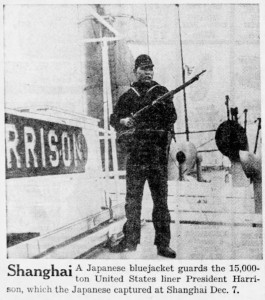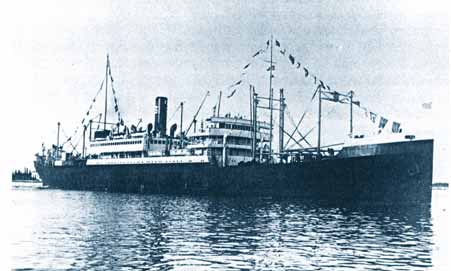Posted: December 17th, 2015 | No Comments »
“East of Cairo” was an NBC radio show – a “dramatic sketch” – that ran around 1930. It was a half hour long yarn focussing on places, obviously, east of Cairo. Invariably the stories involved Americans getting mixed up in something or other in the Far East and many listeners apparently liked the show for its “Oriental” music. A few big names occasionally appeared including Agnes Moorehead. In 1930 this episode delved into the world of Sing-Song girls and the infamous houses of the Foochow Road (Fuxhou Road)….

Posted: December 16th, 2015 | No Comments »
The recent ruckus at Missouri University made me wonder if the Chinese lions are still there? They were in the archway between Neff and Williams halls at the School of Journalism? Anyone know? They were certainly there a few years ago but I wondered if they got to stay.
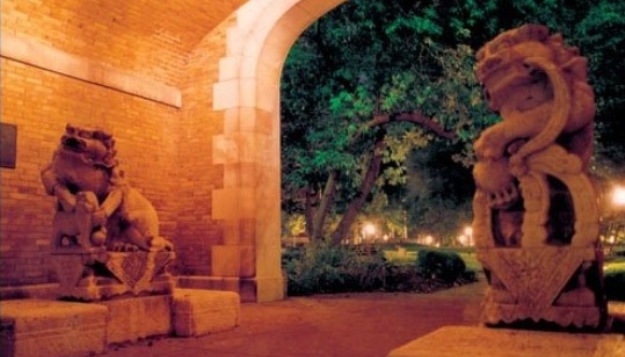
The two stone lions, which once guarded a Confucian temple in Nanking, were given to the School of Journalism by the Chinese government as an act of international goodwill May 7, 1931, during the 22nd annual Journalism Week. Missouri trained a lot of American and Chinese journalists that went to China and Asia between the wars including Carl Crow, JB Powell, Benjamin Fleisher, HS Jewell, Morris J Harris, Henry Francis Frank Misselwitz, Joseph Glen Babb, Hollington Holly K Tong, Hin Wong, Kan Lee, David Wu, Woo Kya-tang, Yoshinori Bob Horiguchi as well as the female journalists Eva Chang and Louise Blakeney Wilson.
The first dean of the School of Journalism, Walter Williams (who himself visited China several times), left below, then University President, accepts the lions from Wu Chao-chu, right, minister of the Republic of China to the United States. Dr. H.H. Kung, China’s minister of industry and a descendant of Confucius, arranged to have the sculptures given to the school after he became acquainted with journalism alumni working in China. The figures were sculpted by an unknown artist around 1400, at the beginning of the Ming dynasty.
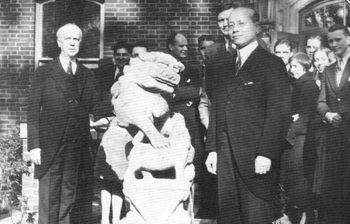
Posted: December 15th, 2015 | No Comments »
1932 – Japan invaded Manchuria and the Chinese portions of Shanghai. The media decided that this was one of the “high spots” of the year along with: the jailing of Al Capone, the assassination of the French President; the murder of an army wife in Honolulu; the Lindbergh baby kidnapping; Emilia Earhart solo-ing the Atlantic; FDR winning the Democratic nomination; riots with the Bonus Marchers, Gandhi on hunger strike and the Mayor of New York indicted on corruption charges…
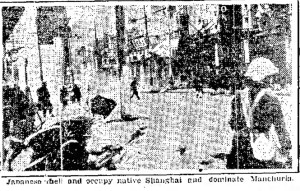
Posted: December 14th, 2015 | No Comments »
From Murdoch to Kuok to Ma…but back in the day the SCMP was the proud possession of an American dentist….
After having lampooned its launch in 1903, the Hongkong Telegraph was merged into the South China Morning Post in Hong Kong (where newspapers always appeared to be far more businesslike than in the treaty ports) when Jardine Matheson’s wealthy Eurasian comprador Robert Hotung sold a controlling interest in the Telegraph to Dr. Joseph Whittlesey Noble in 1916. Noble, from Pennsylvania, was Hong Kong’s second registered dentist who had been in practice in the colony since 1887, meaning that the Post held the dubious distinction of being the only newspaper in the world to be owned by a dentist.

Â
Posted: December 13th, 2015 | 1 Comment »
The Chicago Tribune has a great series of photographs of the city’s Chinese community from the 1930s to the 1970s. They include the community’s support for China in World War Two, celebrity visits, criminals, school etc etc… well worth a look – click here.
Below some Chinese gangsters pulled in in the 1930s Hip Song Tong wars….

Posted: December 12th, 2015 | No Comments »
As the South China Morning Post is now probably about to exit the market as a serious independent newspaper (mainland firm Alibaba having agreed on Friday to buy the media assets of the SCMP Group) it might be worth recalling its rather rocky start back in 1903…
From my book Through the Looking Glass: China’s Foreign Journalists from Opium Wars to Mao….

The Arrival of the Post
At the same time, the press in Hong Kong was growing but it wasn’t exactly a boom time: by the early 1920s the combined circulation of English-language papers in the colony was barely 5,000 daily. The South China Morning Post was founded in 1903 and published its first edition in November, declaring itself the colony’s first “modern newspaperâ€. The press was also becoming a force for social progress in Hong Kong by making suggestions that influential citizens of the colony adopted. Hong Kong’s China Mail first proposed combining the existing medical and technical colleges to form a university for the colony, an idea the Parsi businessman Hormusjee Mody took up at the insistence of prominent businessman Paul Chater and bequeathed its major building to the new Hong Kong University. Unfortunately, Mody died before the university building was completed.
The South China Morning Post, or the Post as it quickly became commonly known by everyone, was to outlive its major competitors, the Hongkong Telegraph, the Hongkong Daily Press and the China Mail to become regarded as one of the best papers in the Far East. The Post’s launch wasn’t popular with the competition. As the Hongkong Telegraph noted, “Hongkong’s troubles are to be increased by the addition of a new daily newspaper with the voluminous title of The Morning Post of South China … We sympathise deeply with Hongkong. It will soon be as bad as Shanghai in this respectâ€. The paper’s founders —Arthur Cunningham who had covered the Sino-Japanese War for the Hongkong Daily Press in 1894 and the Australian-born Chinese political activist Tse Tsan-tai — begged to differ. The Post marked somewhat of a sea change in Hong Kong, declaring in its opening editorial on 6 November 1903:
The modern newspaper has taken the place of the old-time ambassador. The cynic has said the ambassador is sent abroad to lie for the good of his country. The newspaper is sent abroad to tell the truth for the good of humanity. Whereas the ambassador, by means of weary months of negotiation, may make or prevent a war; a newspaper by means of a few trenchant articles, so be that they have truth behind them, will rouse a public to resent aggression, so to reform abuses, to mould the policy of governments. Such is the power of the modern newspaper.
Tse Tsan-tai, who had been baptised James See, was a particularly transnational character for the times. Born in Grafton, Australia, to a family of Chinese merchants, he moved to Hong Kong in 1887 to study at Queen’s College and was one of the founders of the Literary Society for the Promotion of Benevolence (Furen Wenshe). In 1895 Tse and his colleagues aligned themselves with Sun Yat-sen’s Hing Chung Hui (Society for the Restoration of China), though Tse and Sun soon fell out. Tse recalled Sun as “… a rash and reckless fellow. He would risk his life to make a name for himself. Sun proposes things that are subject to condemnation — he thinks he is able to do anything — no obstructions — ‘all paper!’â€. Though history has crowded out Sun’s detractors
in the early days before he rose to power, there are many and his nickname was the “windbagâ€. Later, in the 1930s, a heated debate would arise in Australia when some prominent overseas Chinese campaigned to have Tse recognised as the true father of the Chinese Republic, thereby arguing for the demotion of Sun.
Tse pushed hard for social change in Hong Kong, arguing that the Chinese community should elect the Chinese representatives on the Legislative Council rather than having them nominated by the governor, as well as inventing an advanced steering system for airships. He campaigned against superstition, feng shui, footbinding and opium smoking, while promoting religious tolerance, railways and mining, and calling for the protection of China’s heritage. He had corresponded with Morrison since the 1890s, was friendly with the Hongkong Telegraph editor Chesney Duncan and also knew Cunningham well when he was the editor of the Hongkong Daily Press. In 1901 Tse worked briefly for the China Daily, the newspaper of the Society for the Restoration of China. As well as being a prolific journalist and newspaper proprietor, Tse also authored about half a dozen books on subjects ranging from ancient Turkestan to solving unemployment, to why typhoons occur. He was nothing if not a multi-tasker.
Tse and Cunningham appointed Douglas Story as the paper’s first editor. Their founding aim was to present the viewpoint of both the British colonial regime and the business community and promote the cause of republicanism in China. This was a tricky project and wasn’t an easy balancing act. Story only lasted a year, claiming that he didn’t like Hong Kong because people took too many holidays and played too much sport. However, he was a staunch supporter of self-government for Hong Kong and considered the governor’s post unnecessary. Transition from a crown colony to a self-governing colony would allow Hong Kong to flourish and also allow for greater Chinese involvement in affairs. Although in a seeming contradiction to opposing crown colony status, he also staunchly defended the rights of British trade in China and spoke out against what he saw as American encroachment on British business interests — Washington’s “Open Door†policy.
Despite all this, the Post’s early survival was far from sure. Within a few years at the turn of the century several new papers, as well as the Post, appeared in Hong Kong along with the nearby Canton Daily News, which sought to compete with the rather larger and well-established Canton Chronicle. It seemed that, although the market was already crowded, investors thought newspapers were a potentially profitable investment, but this wasn’t initially the case. Despite the rather vague claims from the backers of the Post that investments in the paper would earn returns of anywhere between 12% and 200% a year when they issued $150,000 worth of shares at $25 each, three years later shareholders had received no dividends and the shares were valued at just $18. The Hongkong Telegraph gloated over the Post’s initial financial woes, noting both the difficulty of the English- language newspaper business in Asia and remembering the early days in the Canton factories: “Conditions in the Far East have changed since the time when anybody could come along with a hand press and start a paper …â€. Despite this gloomy prognosis, the Post persisted and ultimately outlasted all the competition.
The Post survived its early traumas. Various acting editors ran the paper until 1910 when Angus Hamilton was appointed, but he lasted only a few months. Hamilton, an English correspondent of aristocratic background, had started out working on the New York Evening Sun which sent him to Korea. He then found work as a war correspondent for the Times, covering the defence of Mafeking alongside Baden Powell before moving to the Pall Mall Gazette where he covered the Siege of the Legations, the wars in Somaliland and those between the Balkans and Macedonia at the turn of the century. Then, job-hopping again, the Manchester Guardian hired him to report from the frontlines during the 1905 Russo-Japanese War, and he also visited Afghanistan before finally being hired by the Post. Though an immensely talented man, he was also troubled and restless. He lingered in Hong Kong for only a short while before heading to India and then becoming a reporter for Britain’s Central News Agency in the Balkans where he was twice captured by the Bulgarians and severely tortured as a Turkish spy. He travelled to America to give a series of lectures on his experiences around the world, only to discover he was a poor speaker, nervous and attracting small audiences. Considering himself a failure, in dire financial straits, suffering from ill-health courtesy of his Bulgarian torturers and unsure of the future, he cut his throat in a New York hotel room.
As the immediate terror of the Boxers receded, China found itself faced with new challenges — a continually ossifying Qing court that had caused the humiliation of China, as a result of which the country had to accept a greater foreign presence on Chinese soil. At the same time, other rising powers chose China as a battlefield for their grievances.
Posted: December 11th, 2015 | No Comments »
Seeing images from Beijing this week of the disgusting air quality did make me think that, pollution aside, Peking was always a fairly foggy city. It certainly was in 1976 when Dick Nixon, by then a former president, flew in to a “pea-souper” (other papers described it as a “cold mist”) at Peking Airport for the fourth anniversary of his historic 1972 rapprochement visit. They arrived late at night so I’m not sure a picture survives of the actual fog.

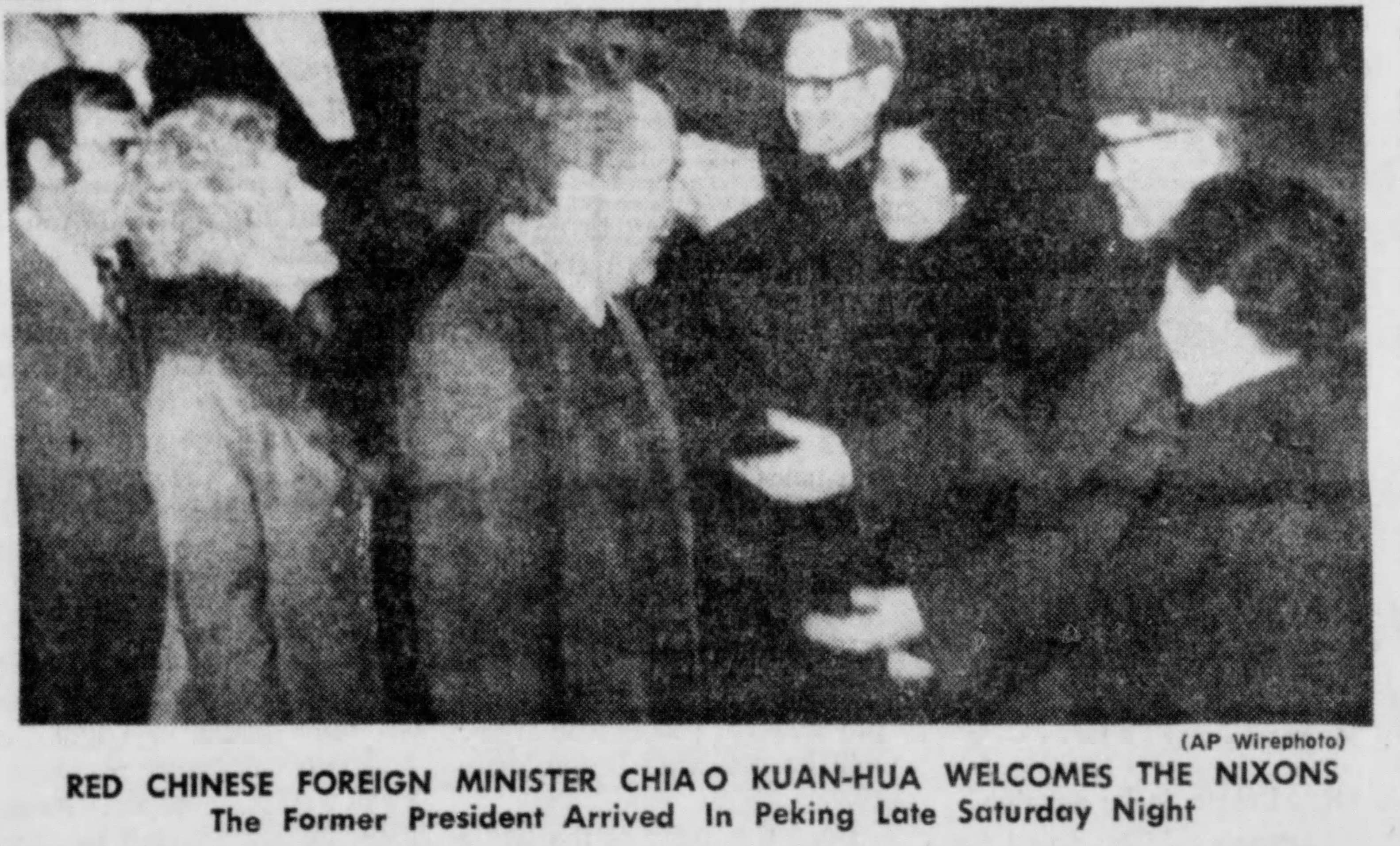 Qiao Guanhua meets Dick and Pat at Peking Airport. Qiao was Foreign Minister but associated with the Gang of Four. When Mao died a few months later in September he was sacked, sidelined and never regained any significant political authority. The woman with Qiao is presumably Zhang Hanzhi, his second wife and an English interpreter for Mao himself at times. She had been Nixon’s translator in ’72. Her divorce from her first husband had been a “Red Scandal” in 1973 and Qiao was 22 years her senior.
Qiao Guanhua meets Dick and Pat at Peking Airport. Qiao was Foreign Minister but associated with the Gang of Four. When Mao died a few months later in September he was sacked, sidelined and never regained any significant political authority. The woman with Qiao is presumably Zhang Hanzhi, his second wife and an English interpreter for Mao himself at times. She had been Nixon’s translator in ’72. Her divorce from her first husband had been a “Red Scandal” in 1973 and Qiao was 22 years her senior.
Posted: December 11th, 2015 | No Comments »
Actually this is December 8th in Shanghai – though it was December 7th in Pearl Harbor. After the Japanese attack on America began it was about 4am when Shanghai heard. The Japanese moved swiftly and here is the President Harrison under Japanese Bluejacket Marine guard this week in 1941…
The story of the Harrison is compelling and told in David and Gretchen Grover’s Captives of Shanghai. The President Harrison was formerly the Wolverine State American Passenger Vessel later renamed Harrison in 1922 operated for the U.S. Shipping Board in U.S. Pacific coast/East coast of South America trade. The ship was transferred to Dollar Steamship Lines in 1923 and inaugurated the Dollar Line’s first Round-the-World service in 1924. In December 1941 the Harrison was chartered by the US government to evacuate the last of the 4th Marines and Navy personnel from Shanghai. While on her way to Chinwangtao (Qinhuangdao now) to embark a few more stranded Marines she was captured by the Japanese Navy off Shanghai on the 8th December 1941 close to the Saddle and Shaweishan Islands (now the Ma’an Liedao and Zhoushan Dao respectively) at the mouth of the Yangtze.
The Harrison was later renamed the Kakko Maru and flagged as Japanese. On the 12th September 1944 she was sunk by a torpedo from the American submarine USS Pampanito off Hainan Island heading for Formosa. Sadly she was carrying Australian and British prisoners of war, who had survived the building of the Death Railway.
